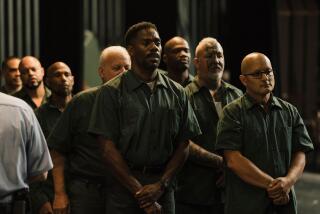Doing âRedemptionâ Time in a Former Prison : Movies: For a story about inmates, the crew takes over an abandoned Ohio reformatory. After weeks there, some find the spot, well, confining.
MANSFIELD, Ohio â âWhy donât we do a shot of him alone?â Frank Darabont suggests. The first-time feature film director is having some timing problems with a temperamental four-legged actor.
The crew snickers as the first assistant director clears the set: âLetâs all step out, please, so we can make room for the rat . . , â he shouts. â And the actor.â
Although they look to be right in their element, the two rats (one is an understudy) are not necessarily comfortable in the solitary confinement sector of the Ohio State Reformatory. But then neither is the film crew, and its members have been shooting âThe Shawshank Redemptionâ here for more than two months. About a dozen people are crowded into a narrow hallway, stale-aired and damp even though it hasnât rained in central Ohio in weeks.
Nine takes later, the rats are given the same send-off all actors get when theyâre done with the shoot: âLadies and gentlemen, the rats are now officially between shows,â followed by light applause from the cast and crew.
âThe Shawshank Redemption,â a Castle Rock release starring Tim Robbins and Morgan Freeman due out next year, is the tale of a mild-mannered banker convicted of murder (Robbins), as told by a hardened lifer (Freeman). The story, adapted from a Stephen King novella, spans 20 years--nearly all of them behind the walls of the Shawshank maximum-security prison in Maine.
âThis place gives me the willies, it really does,â says producer Niki Marvin. But thatâs the reason she chose it. She spent five months researching prisons all over the United States and Canada before deciding on the reformatory. The sprawling complex of Gothic-style stone and brick buildings had the two qualities she was looking for: It had a timeless style and was absolutely empty.
*
Until the mid-1980s, the reformatory, built in 1896, housed between 2,300 and 3,300 inmates, all first-time offenders between the ages of 18 and 30. But in December, 1990, the new Mansfield Correctional Institute was completed and all the prisoners were moved there.
âFor the volume of what weâre shooting, we couldnât shoot in a functioning prison,â Darabont says. âI know people who have shot in a real prison, and for the first two hours it was security checks going in and for the last two hours security checks going out.â
Darabont was already an established writer in Hollywood (âThe Fly II,â âThe Blob,â âNightmare on Elm Street III: Dream Warriorsâ) when he optioned the rights to the story about five years ago knowing he wanted to direct it. He had become a King aficionado long before, however, and had even directed a short film version of Kingâs story âThe Woman in the Room.â That wasnât going to land him a chance to direct a feature, though. So he directed a cable movie for the USA Network to get experience with feature-length material.
Then, four years after he optioned it, Darabont finally sat down and wrote the script. He calls the delay âa massive case of work avoidance,â apparently a recurring problem. âItâs like solitary confinement: You know youâre going to be there for a while,â he says. For âRedemption,â his stint was eight weeks.
The 1982 King bestseller âDifferent Seasons,â from which the story is taken, also contains âThe Body,â which became the 1986 Castle Rock hit âStand by Me,â directed by Rob Reiner. Itâs no coincidence that Darabont and Marvin took âRedemptionâ to Castle Rock. âThe reason we went there was really because of âStand by Me.â And Rob Reiner. We thought they would have a sensitivity to this material,â he says.
Much like âStand by Meâ and the companyâs âMisery,â Darabontâs movie is atypical Stephen King in that itâs low on things that go bump in the night. Rather, itâs a tale of hope; a small, personal story. At least thatâs how it seemed on the page.
âItâs bigger than I thought,â Darabont says. âThe script sort of reads like a little character piece, until you get to the prison and the 200 extras.â
With the strength of the script--literally every actor on the set insists it was the best he had read in years--and the reputation of Castle Rock, Darabont and Marvin attracted some top names. In addition to Freeman and Robbins, Oscar-winning production designer Terrance Marsh (âDr. Zhivagoâ) signed on, as did noted cinematographer Roger Deakins (âBarton Finkâ).
Just in case anyone was getting too comfortable in his or her complimentary Ohio Film Commission T-shirt, out came Money magazine with its annual livability ranking. Of the 300 most populous places in the United States, Mansfield was No. 297.
Everyone has found his or her way to cope with being away from home. âEverything I want is here. My wife sent my horse,â says Morgan Freeman. Yup, the quarter horse was trailered up from Freemanâs home in Mississippi and boarded south of town so the actor could ride when he has time.
Freemanâs character Red is Irish in the book. The only change Darabont made in the script was in the way the character gets that name. âAnd in the prison system in Maine, less than 1% of the prison population was black, so itâs a bit of a sociological stretch. But who cares? Heâs Morgan Freeman, and heâs great,â says Darabont.
Freeman, whose directing debut, âBopha!,â was released earlier this fall, felt empathy for Darabont. âYour first time out, youâre always fraught with anxiety,â he says. âItâs just a matter of being as helpful as possible.â
*
What got him interested in this project? âMoney. A job. Work,â Freeman says. After some prodding, he adds: âItâs an interesting script. I like Castle Rock--they do good stuff. And thereâs Rob Reiner--Iâll do anything to be associated with him. And Tim Robbins. And it pays well.â
Freeman is to be released from shooting the next day, which will give him a little free time to sail from where his boat is docked in the Virgin Islands to St. Croix, where the final scenes of âRedemptionâ will be shot. And what will be next for the twice Oscar-nominated actor? âI very seldom have a ânext project,â â he says. âEverybody thinks Iâm in great demand. But Iâm not.â
Tim Robbins is in great demand. And he, too, is tired--something emphasized by the cosmetically applied whiskers, bloodied nose and dirty face. Heâs spent the last 90 minutes crammed into a mock solitary confinement cell--one actually smaller than the real ones in the prison--through all rehearsals and takes.
âFor that kind of scene, it doesnât make sense to sit and have Evian brought to you,â he quips over lunch in his trailer.
*
Robbins had a banner year in 1992. He took best actor honors at Cannes for his role in Robert Altmanâs âThe Player.â The political satire âBob Roberts,â which he wrote, directed and starred in, also earned critical acclaim. And, he notes, the Actors Gang, a Los Angeles Theater group he co-founded, was listed in Newsweek as part of âthe cultural eliteâ former Vice President Dan Quayle was railing against.
âElite is not one of the words I would use to describe the Gang,â he says. âBut if weâre going to be on any list that raises the ire of shallow people, then I stand on that list proudly.â
Robbins went on to star in Altmanâs âShort Cutsâ and will be seen early next year in Joel and Ethan Coenâs âThe Hudsucker Proxy.â It was on the âHudsuckerâ set in North Carolina that Darabont and Marvin wooed him to play Andy Dufresne in âRedemption.â
âIt was the best script Iâd read in a couple of years,â he says. âI really intended to not be working, but this opportunity was . . . too challenging. I also wanted to work with Morgan Freeman.â
Robbins called working in the reformatory âpretty overwhelming to begin with. Very oppressing feeling when you walk in the place. Walls of Angst. Pain. Ghosts,â he says, pausing a full three seconds between the final words, seemingly poking fun at his own melodramatics.
But he gets more serious when he refers to the cemetery outside the old reformatory. Inmates who died in prison and whose remains were not claimed were buried in the small plot, their graves marked only with their serial numbers.
âTo not even allow the man dignity in his death by giving him back his name . . . (thatâs a) kind of indication of the way things were run around here.â
The primary relationship in the film is between Robbinsâ Andy and and Freemanâs Red. Whereas Red is the âguy who can get it for youâ--âitâ being anything from cigarettes to a poster of Rita Hayworth--Andy furnishes the hardened lifer with the one thing he doesnât realize heâs been missing: a sense of hope.
âOn paper, a nice relationship develops,â Robbins says. âAndyâs journey has very little to do with prison and more to do with belief and inner strength and being able to find a way to live outsideâ the prison walls.
Still, weeks of shooting behind bars has Robbins itching to break out of this routine. He wants to hear a decent radio station. He wants to take his kids to school.
âI canât wait to get back to New York,â Robbins says. âYou can pretty much count on seeing something out of the ordinary every day.
âEveryoneâs ready to be in a place where thereâs some choices. To put it politely.â
So what if thereâs not a Thai restaurant or foreign film to be found? Thereâs certain amount of prestige in being the biggest show --or really, the only show in town.
âYou get so blase in L.A.,â says Marvin, the producer, watching two locals taking snapshots of the trucks of lighting equipment. âThey will photograph anything, like our cars parked there. Itâs endlessly fascinating.â
More to Read
Only good movies
Get the Indie Focus newsletter, Mark Olsen's weekly guide to the world of cinema.
You may occasionally receive promotional content from the Los Angeles Times.










